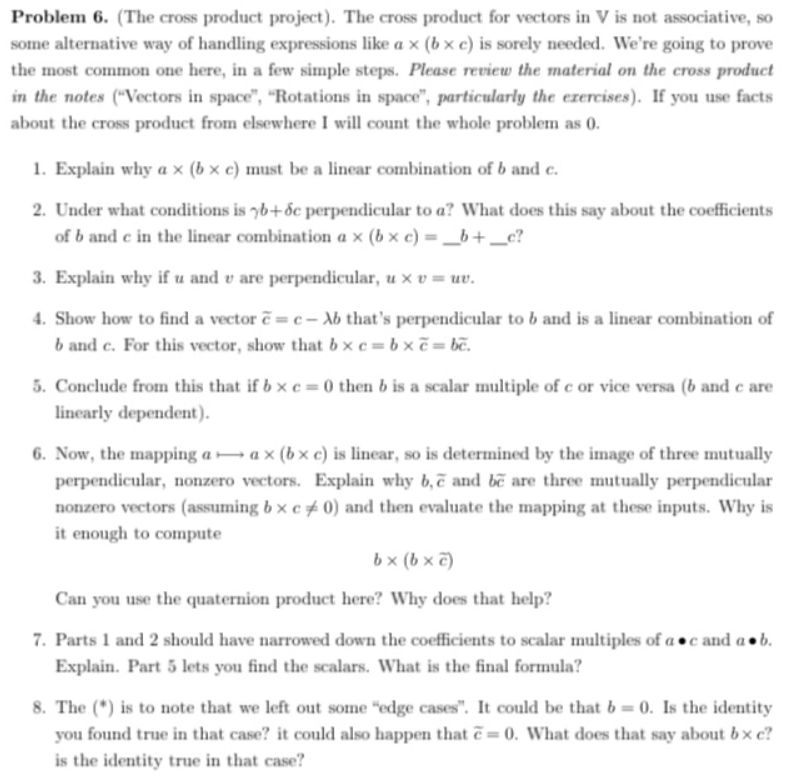4. Show how to find a vector ẽ = c – Ab that's perpendicular to b and is a linear combination of b and c. For this vector, show that b x c = b x ē = bē.
4. Show how to find a vector ẽ = c – Ab that's perpendicular to b and is a linear combination of b and c. For this vector, show that b x c = b x ē = bē.
Trigonometry (MindTap Course List)
8th Edition
ISBN:9781305652224
Author:Charles P. McKeague, Mark D. Turner
Publisher:Charles P. McKeague, Mark D. Turner
Chapter7: Triangles
Section: Chapter Questions
Problem 1RP: We mentioned in Section 7.5 that our algebraic treatment of vectors could be attributed, in part, to...
Related questions
Question
solve question 4 with explanation asap and get upvotes

Transcribed Image Text:Problem 6. (The cross product project). The cross product for vectors in V is not associative, so
some alternative way of handling expressions like a x (b x c) is sorely needed. We're going to prove
the most common one here, in a few simple steps. Please review the material on the cross product
in the notes ("Vectors in space", "Rotations in space", particularly the ezercises). If you use facts
about the cross product from elsewhere I will count the whole problem as 0.
1. Explain why a x (b × c) must be a linear combination of b and c.
2. Under what conditions is yb+ ốc perpendicular to a? What does this say about the coefficients
of b and e in the linear combination a x (b × c) = _b+ _c?
3. Explain why if u and v are perpendicular, u x v = uv.
4. Show how to find a vector ẽ = c – Xb that's perpendicular to b and is a linear combination of
b and c. For this vector, show that b x c = b x ẽ = bẽ.
5. Conclude from this that if b x e = 0 then b is a scalar multiple of c or vice versa (b and c are
linearly dependent).
6. Now, the mapping a → a x (b x c) is linear, so is determined by the image of three mutually
perpendicular, nonzero vectors. Explain why b,ẽ and be are three mutually perpendicular
nonzero vectors (assuming b x c ± 0) and then evaluate the mapping at these inputs. Why is
it enough to compute
b x (b x e)
Can you use the quaternion product here? Why does that help?
7. Parts 1 and 2 should have narrowed down the coefficients to scalar multiples of a •c and a• b.
Explain. Part 5 lets you find the scalars. What is the final formula?
8. The (*) is to note that we left out some "edge cases". It could be that b = 0. Is the identity
you found true in that case? it could also happen that ẽ = 0. What does that say about bx c?
is the identity true in that case?
Expert Solution
This question has been solved!
Explore an expertly crafted, step-by-step solution for a thorough understanding of key concepts.
Step by step
Solved in 2 steps with 2 images

Recommended textbooks for you

Trigonometry (MindTap Course List)
Trigonometry
ISBN:
9781305652224
Author:
Charles P. McKeague, Mark D. Turner
Publisher:
Cengage Learning

Trigonometry (MindTap Course List)
Trigonometry
ISBN:
9781305652224
Author:
Charles P. McKeague, Mark D. Turner
Publisher:
Cengage Learning